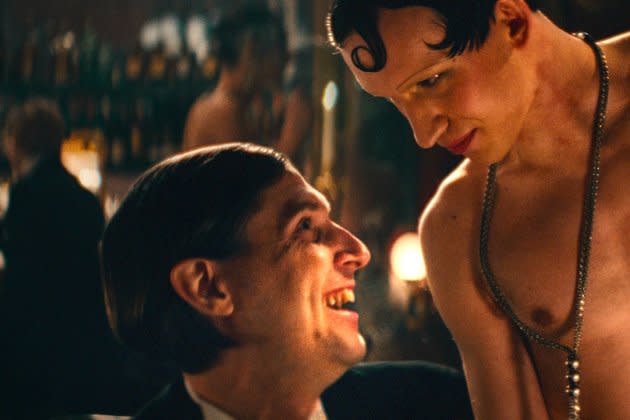Netflix Exposes the Secret Gay History of Nazi Germany

The Eldorado, the swinging, anything-goes nightspot that gives the new Netflix documentary Eldorado its name, was an LGBTQ haven during Germany’s Weimar Republic, popular among Berlin’s trans population and anyone else who liked to let their hair down in public. It was also, as the film’s subtitle puts it, Everything the Nazis Hate. Which didn’t stop burly Hitler confidante and head of the Nazi SA paramilitary wing Ernst Röhm, a not-terribly-closeted gay man, from frequenting the establishment. As the film explains, the SA had a strong homoerotic element, a disgust with women and femininity they somehow used to justify homosexuality – for a time, anyway. At a certain point, Röhm’s friendship with Hitler could only take him so far in a Nazi regime increasingly set on eradicating homosexuality.
Röhm is but one player in this concise, deftly told doc that uses the Eldorado as a launching pad into a broader story about being gay in Nazi Germany. It’s a tale of wild nights, forbidden relationships, and, eventually, horrible consequences, a decadent scene leading to a nightmare conclusion. The film never comes out and yells it, but it is also a reminder of the Final Solution tenor that still accompanies much anti-gay and anti-trans rhetoric and, increasingly, policy.
More from Rolling Stone
Trans Influencer Dylan Mulvaney Breaks Her Silence on Bud Light Controversy
'Bottoms,' a Horny, Queer 'Fight Club,' Is the Comedy Movie of the Summer

Some of this material has been covered in the 2000 documentary Paragraph 175, named for the provision of the German Penal Code that made sexual relations between males a crime (it wasn’t repealed until 1994). And of course, there’s always Cabaret. But directors Benjamin Cantu and Matt Lambert still find plenty of ways to make Eldorado feel fresh. The reenactments are strikingly lit and acted, bringing the scene to life and enhancing the specificity of the time and place. The experts are well-chosen, the research always relevant, and the archival material of the Third Reich’s oppressions is ample. (The Nazis were nothing if not prolific self-chroniclers). But the film makes its greatest impact through the individual stories weaved throughout the bigger picture, the internal conflicts, the passions shared, the lives destroyed.
Some of the main characters are well-known. Gottfried von Cramm was the pride of German tennis — handsome, blond and blue-eyed, and the No. 1 ranked player in the world in 1937. He was also a bohemian spirit who had a passionate homosexual relationship with Manasse Herbst, a Galician Jewish actor who fled Germany in 1936. The Reich was willing to look the other way as long as Cramm played the good Aryan and kept winning. But when he lost to the American Don Budge at Wimbledon in 1937, and denounced the Nazi regime’s increasingly aggressive persecution of Jewish people, he was deemed expendable. Gottfried was arrested and imprisoned for violating Paragraph 175 and struggled to have his “crime” expunged from his record after the war.
Others here are less famous. Charlotte Charlaque and Toni Ebel were Eldorado regulars and trans pioneers, both of whom had completion surgery at Magnus Hirschfeld’s Institut für Sexualwissenschaft. Hirschfeld, a groundbreaking sexologist, both gay and Jewish and therefore a prime target of Nazi Germany, was thankfully not present when his institute was ransacked by marauding Nazi youth (here again, there are photos). An early proponent of LGBTQ rights, he was forced into exile in France, where he died in 1935, before the very worst that his country ultimately committed.
Eldorado is one of those documentaries that gives texture and context, faces and voices, to a well-chronicled period and set of circumstances. It does so with style, sensitivity, and a respect for the history it examines. Here we experience the decadence that thrived before the fall, at a hideaway for those whose differences would soon mark them for prison, exile, or, in many cases, death (it is estimated that between 5,000 and 15,000 gay people died in the concentration camps for violating Paragraph 175). We can’t change what hate looked like then. But it remains essential to take note and try to stop its encroachment now.
Best of Rolling Stone

